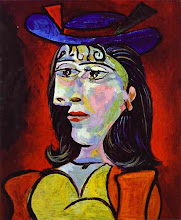 There’s a Beowulf frenzy going on right now. I blame Angelina Jolie. My local children’s bookstore, the Red Balloon, has part of a shelf devoted to it. Apparently, anything with five or more books constitutes a “section”. I rummaged through the various versions, including the one with a big shiny sticker proclaiming, “Now a major motion picture!”, and settled on Gareth Hinds’ beautifully illustrated and satisfyingly gory graphic novel (the ladies at the Red Balloon still say comic). Text is kept at a minimum and is based on the 1909 translation by A.J. Church. This is irrelevant to me as this is my first Beowulf, but it may matter to someone out there in the ether. Although scarce, the words have not been emasculated. Kids are still going to have to grapple with sentences like, “Of savage and merciless temper was she, and now she was wrought to fury by the woe of her son”. I’d be more motivated to tackle words like “liegeman” and “burnish” on a page full of beheaded soldiers and torn limbs, wouldn’t you? This thousand-year-old narrative is expertly told in both pictures and words,
There’s a Beowulf frenzy going on right now. I blame Angelina Jolie. My local children’s bookstore, the Red Balloon, has part of a shelf devoted to it. Apparently, anything with five or more books constitutes a “section”. I rummaged through the various versions, including the one with a big shiny sticker proclaiming, “Now a major motion picture!”, and settled on Gareth Hinds’ beautifully illustrated and satisfyingly gory graphic novel (the ladies at the Red Balloon still say comic). Text is kept at a minimum and is based on the 1909 translation by A.J. Church. This is irrelevant to me as this is my first Beowulf, but it may matter to someone out there in the ether. Although scarce, the words have not been emasculated. Kids are still going to have to grapple with sentences like, “Of savage and merciless temper was she, and now she was wrought to fury by the woe of her son”. I’d be more motivated to tackle words like “liegeman” and “burnish” on a page full of beheaded soldiers and torn limbs, wouldn’t you? This thousand-year-old narrative is expertly told in both pictures and words, 
“There the tide washes in and sprays the forests with its brine. Clouds shroud the waters and wet winds wail through the trees.”
Any male middle grader hoping for a glimpse of an Angelinaesque beauty in tight fitting robes is going to be sorely disappointed. For the ladies, however, you see a lot of Beowulf. Not all. But nearly. On a more serious note, there is an image of pre 9/11 New York that suddenly appears when King Hrothgar is lecturing Beowulf on the danger of too much pride and power after Beowulf has successfully slain Grendel and his monstrous mother. “Come in what shape it may, death will subdue even thee, thou hero of war.” Which, of course, it does.





